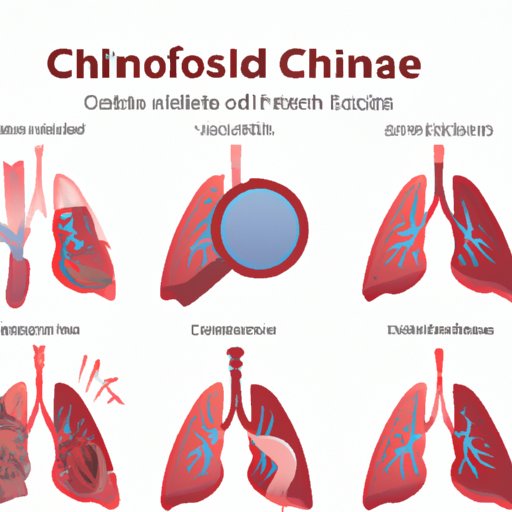
I. Introduction
Chronic lung disease affects millions of people worldwide and is a major cause of disability and death. It is a condition that affects the lungs and makes it difficult to breathe, leading to a decrease in lung function. This article aims to provide a comprehensive guide to chronic lung disease, including its causes, symptoms, types and treatment options. It is intended for individuals living with chronic lung disease, their families and caregivers, as well as individuals who wish to learn more about this condition.
II. A Comprehensive Guide to Understanding Chronic Lung Disease
Chronic lung disease, as the name suggests, is a condition that affects the lungs and causes a decrease in lung function over time. It is different from acute respiratory disease, which refers to a sudden onset of symptoms that typically resolve within a few weeks. Chronic lung disease, on the other hand, is a long-term condition that gradually worsens over time. It can result from a wide range of causes, including smoking, pollution, genetics, and other environmental factors. Chronic lung disease can lead to a range of long-term consequences, including decreased quality of life, disability, and even death.
III. Exploring the Causes and Risk Factors of Chronic Lung Disease
Chronic lung disease can result from a range of causes, including smoking, pollution, genetics, and other environmental factors. Smoking is the leading cause of chronic lung disease, as it damages and irritates lung tissue over time, leading to a reduction in lung function. Pollution, both indoor and outdoor, can also increase the risk of chronic lung disease, as it exposes the lungs to toxins and pollutants that can damage lung tissue. Genetics and other factors, such as a history of lung infections or exposure to toxins in the workplace, can also play a role in the development of chronic lung disease.
IV. Different Types of Chronic Lung Disease and Treatment Options
There are many different types of chronic lung disease, each of which affects the lungs in different ways. Chronic obstructive pulmonary disease (COPD) is the most common type of chronic lung disease, and it results from damage to the lungs caused by smoking or other factors. Asthma is another type of chronic lung disease, characterized by episodes of wheezing and difficulty breathing that can be triggered by allergens or other irritants. Pulmonary fibrosis is a type of chronic lung disease that causes scarring of the lungs, which can lead to a decrease in lung function over time.
The treatment of chronic lung disease depends on the type and severity of the condition. Medications, such as bronchodilators and steroids, can be used to manage symptoms and improve lung function. Inhalers and nebulizers can also be used to deliver medication directly to the lungs, which can be helpful for individuals with chronic lung disease. In severe cases, oxygen therapy and surgery may be necessary to improve lung function and quality of life.
V. An In-Depth Look at the Symptoms of Chronic Lung Disease
Common symptoms of chronic lung disease include shortness of breath, wheezing, chest pain, and coughing. These symptoms can vary depending on the type of chronic lung disease, with some individuals experiencing more severe symptoms than others. Shortness of breath is a common symptom of many types of chronic lung disease and can have a significant impact on an individual’s ability to perform daily activities. The emotional and psychological impact of chronic lung disease on patients and their families should not be underestimated and can contribute to increased stress and anxiety.
VI. Coping with Chronic Lung Disease: Tips, Tools, and Techniques
There are many strategies that individuals with chronic lung disease can use to manage their symptoms and improve their quality of life. Breathing exercises, such as pursed-lip breathing and diaphragmatic breathing, can be helpful for individuals with chronic lung disease. Relaxation techniques, such as meditation and deep breathing, can also be effective in reducing stress and anxiety. Pulmonary rehabilitation, which involves exercise, education, and support, can also be helpful for individuals with chronic lung disease.
Support groups, online forums, and patient advocacy organizations can also be helpful for individuals with chronic lung disease, as they provide social support and important information regarding the disease.
VII. The Impact of Diet and Exercise on Chronic Lung Disease
Exercise and a healthy diet can have a significant impact on an individual’s ability to manage chronic lung disease. Regular exercise can help improve lung function, reduce shortness of breath, and improve overall health. Certain foods, such as those rich in antioxidants and omega-3 fatty acids, can also help improve lung function and reduce inflammation. Individuals with chronic lung disease should avoid foods that can exacerbate their symptoms, such as those high in sugar or salt.
VIII. Living with Chronic Lung Disease: Real Stories from Real People
Living with chronic lung disease can be challenging, but many people have found ways to manage their symptoms and improve their quality of life. Personal anecdotes from individuals with chronic lung disease can be inspiring and offer hope to others facing similar challenges. These stories can also provide important insights into the diagnosis, treatment, and symptom management of chronic lung disease.
IX. Conclusion
Chronic lung disease is a major health concern that affects millions of people worldwide. Early diagnosis, effective treatment, and ongoing support are critical for individuals with chronic lung disease to manage their symptoms and improve their quality of life. By adopting healthy lifestyle habits, using coping strategies, and seeking support, individuals with chronic lung disease can live fulfilling and rewarding lives while managing their symptoms.




